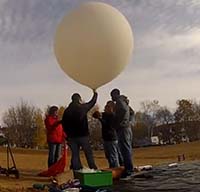
Members of the MCTC Engineering Club collaborated on a balloon launch that reached at least 85,000 feet. From left to right: Kyle Thompson, Yvan Nguetio, Parke Kunkle (MCTC faculty and Engineering Club advisor), Maren Hoye, Madeline Forbes, and Keefe Tarnow.
“Do you remember MEA weekend?” asked MCTC student Maren Hoye. “Because we don’t.”
Maren and four other members of the MCTC Engineering Club spent the long weekend in October culminating a year’s worth of designs, calculations, research and planning. Fortunately, the weather was perfect for balloon-watching.
MCTC math student Kyle Thompson hatched the idea nearly a year ago. He had started a rocket club for fellow aerospace enthusiasts, but realized one day if he wanted to launch something higher, he’d have more luck with a balloon.
Kyle gathered a team of interested students, and they spent the next 11 months preparing to launch a balloon into near-space. “We all pulled from our life experiences and what we learned in our MCTC classes. Everyone was really great at problem-solving,” Maren said.
The group joined the MCTC Engineering Club in the spring semester of 2012 and continued their work through the summer. One problem they faced was being able to track the balloon—both after it launched, and once it fell back to Earth.
“I studied and got my ham radio license,” said Engineering Club member Madeline Forbes. “We needed to find a repeater that would pick up and amplify the signal from our transmitter, and we finally found one on top of Moos Tower at the U of M.”
After nearly a year of preparation—and some help from MCTC professor and one of the Engineering Club advisors, Parke Kunkle—the club was ready to launch their long-awaited project. The day of the launch they brought two GPS transmitters, a GoPro action camera, heat packs, one 1200 gram balloon and a helium tank.
“We were out for 16 hours that day. We probably should have brought lunch,” said Madeline.
One of the most complicated tasks, according to the balloon team, was calculating how much helium they needed to fill the balloon in order to achieve their desired outcome. Once they determined the right amount they spent an hour watching the balloon slowly fill in the softball field that doubled as their launching point.

The day of the launch, group members calculated how much they needed to fill the balloon. Here, the balloon has a diameter of 7 feet.
The group launched the balloon from Big Marine Lake near the Saint Croix River, and tracked its progress using the GPS signals being sent from the balloon’s payload. It took two and a half hours of the balloon rising for it to expand to its maximum capacity—30 feet in diameter. That point, they calculated, was at least 85,000 feet above sea level.
After the team retrieved the popped balloon—which landed about 90 miles away in Wisconsin—they began to analyze what went well, which calculations were off and what they should do next time.
“I learned in chemistry class that the heat packs we used to keep the camera from freezing also create water as a byproduct of their chemical reaction,” said Yvan Nguetio, a member of the group. “That’s why condensation formed on the camera. We brainstormed a method to prevent this from happening next time.”
“I’d like to reach 100,000 feet with the next balloon,” said Kyle. “I’d also like to get better video and more data.” The group wants to use a larger balloon for their next launch, which will need FAA clearance.
Where does someone get a balloon like this?
“Online,” Kyle said.
Stay tuned as the students launch another balloon in the spring.





